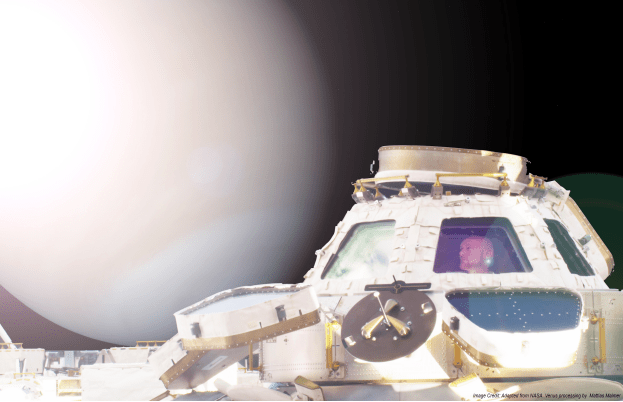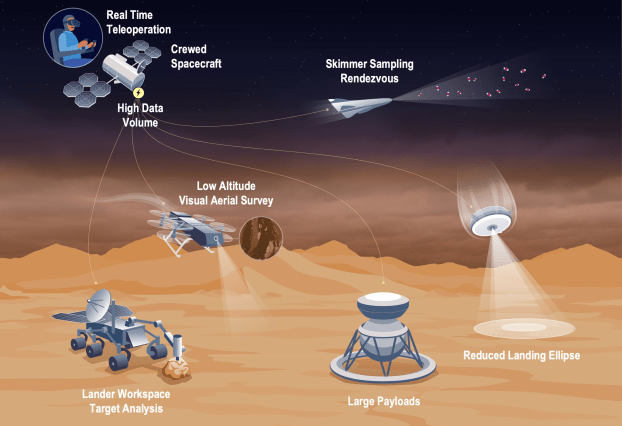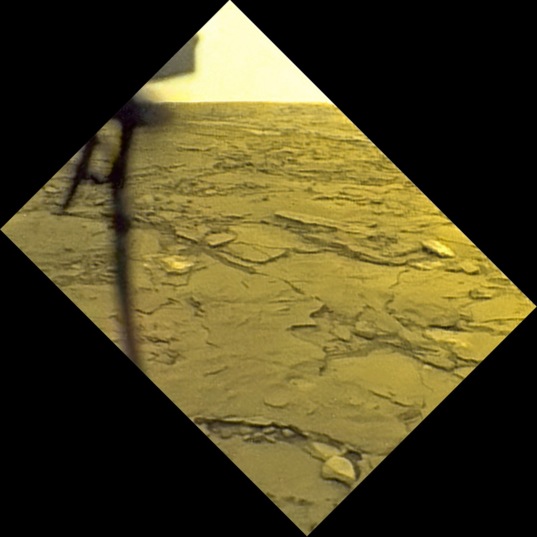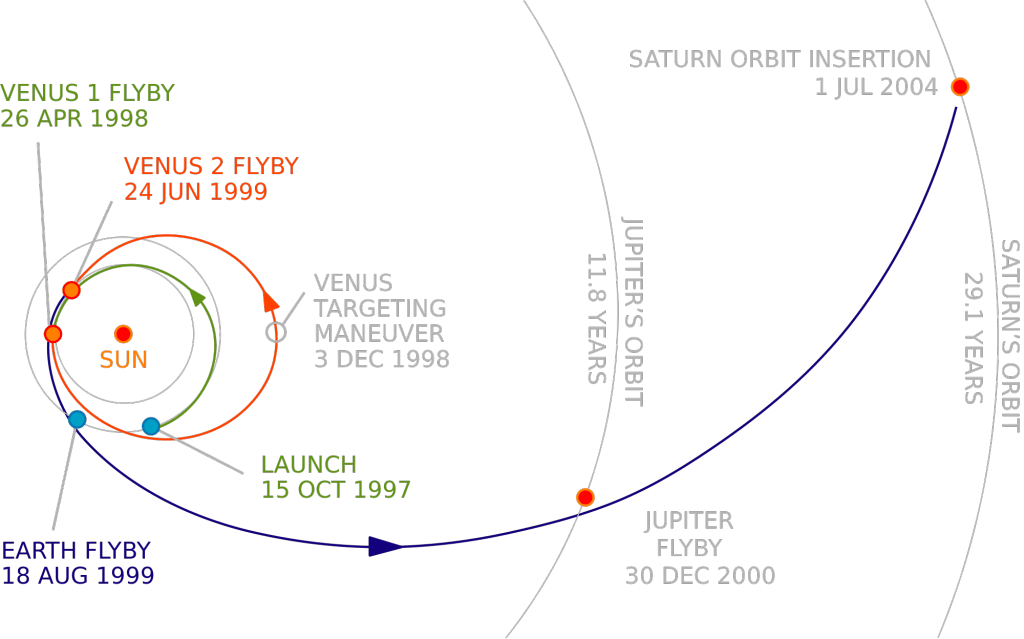Every 26 months, the orbits of both Earth and Mars conspire to make travel between the two planets shorter. Launching in one of these windows means the travel time can be reduced to only six months. Our robotic missions to the Martian surface, and missions that place satellites in Martian orbit, launch during these windows.
But are there other alternatives to this mission architecture?
One group of researchers says that crewed missions to Mars shouldn’t go directly to their destination; they should slingshot past Venus first.
A white paper outlining this idea was written by a group of five researchers from Johns Hopkins University Applied Physics Laboratory, from North Carolina State University, and from NASA. The paper is titled “Human Assisted Science at Venus: Venus Exploration in the New Human Spaceflight Age.” The lead author is Noam Izenberg from JHUAPL, and the paper is available on the pre-print site arxiv.org.
It makes sense to reduce travel time for crewed missions to Mars. Sitting in a space ship, exposed to radiation and microgravity, is hazardous and the time spent doing it should be minimized. But what if a mission to Mars could fulfill other scientific objectives at Venus first, by slingshotting past Earth’s sister planet? And what if the Venus slingshot idea actually made the whole mission safer?

Image of ESA astronaut Alexander Gerst courtesy NASA.
These are the arguments made by the authors in the new white paper.
The debate revolves around two terms that describe mission architecture: conjunction and opposition. In a conjunction mission, a spacecraft travels directly from Earth to Mars, and they launch when the mission duration is shortest. In an opposition mission, a spacecraft can visit other destinations along the way, and a shorter mission duration isn’t as imperative. The Venus slingshot to Mars idea is an opposition mission, because the mission would visit Venus first.
![(Left) Opposition- (“short stay”) and conjunction-class (“long stay”) Mars missions,
respectively, adapted from the Mars Design Reference Architecture (2014) [3]. The opposition
mission (left) is Earth-Venus-Mars and features an outbound Venus flyby en route to Mars.
Optional Earth-return from Venus as a stand alone Earth-Venus Earth (EVE) mission or EarthVenus-Mars abort case is shown with dotted line. Image Credit: Izenberg et al, 2020.](https://www.universetoday.com/wp-content/uploads/2020/07/Venus-missions.png)
respectively, adapted from the Mars Design Reference Architecture (2014). The opposition mission (left) is Earth-Venus-Mars and features an outbound Venus flyby en route to Mars. Optional Earth-return from Venus as a stand alone Earth-Venus Earth (EVE) mission or EarthVenus-Mars abort case is shown with dotted line. Image Credit: Izenberg et al, 2020.
But why?
Visiting Venus on the way to Mars will contribute to the science outcomes, and to the overall safety of the mission, and subsequent missions.
A visit to Venus would help satisfy some of our scientific curiosity. There’ve been a handful of robotic missions to Venus proposed in recent years, but having humans take part in the exploration of Venus, even from orbit, provides benefits.
Drones and robotic exploreres on Venus have to contend with time delays when getting their instructions from operators on Earth. The time delay when communicating between Venus and Earth is anywhere from five to 28 minutes. But having people in orbit would remove that constraint.

adapted from Cassidy et al., 1967. Image by APL/Caleb Heidel.
Having human operators in orbit who are controlling drones and other surface vehicles provides another critical benefit. Venus is a deadly, extreme place, so hot it can melt lead. And the crushing atmosphere on the surface of Venus is equivalent to being under 900 meters (3,000 ft) of water here on Earth. That’s over 90 times more pressure than Earth’s surface.
The environment is very hard on equipment, with some instruments only lasting a couple hours. “High-capability instruments (e.g., LIBS-Raman spectrometers, alpha particle X-ray spectrometers, UV-NIR imagers, etc.) are at present only capable of operating on the Venus surface and near-surface for ~1–2 hours,” the authors write. A real-time human controller would be able to direct exploration equipment and make critical decisions with no delay. Those 1 or 2 hours would not be wasted.
“Real-time communication between a scientist in the flyby crew and
a landed spacecraft on the surface would allow the astronaut to rapidly assess and act upon imaging and compositional data to select targets for maximum science return,” they write, “and to avoid targeting errors such as unintentional sampling, as occurred to the Soviet’s Venera 14 lander.”

The Venera 14 was one of a long series of Soviet Venera probes sent to the surface of Venus, most of which were unsuccessful. In 1982, however, Venera 14 made it to the surface, and quickly got to business. The quartz camera lens covers came off as planned, falling to the surface.
At that point, Venera was in a league of its own. There it was, on the surface of Venus, a toxic blistering hellhole, and its camera was operational, and the lens cover was removed. Venera 14 was going to test the compressibility of the surface with spring-loaded arms, while the camera took pictures of the operation. Sadly, the lander targeted the ejected lens cover itself, and tested and photographed its compressibility, because of where it landed. What a waste.
Venera 14 only survived on the surface for 57 minutes, and it wasted some of its time photographing a lens cap, and testing its compressibility. With a human operator at the controls, parked in orbit, that would never happen.
The pictures from Venera 14’s visit to Venus are our last views of the surface.

A slingshot visit to Venus might simplify another one of the goals in exploring the planet: sample return. “Atmospheric skimmers have been proposed for active sampling of the upper atmosphere of Venus and its near-space environment,” the authors write. “Such fast sample-grab-and-return from the Venus atmosphere, rendezvousing with the departing spacecraft instead of transiting to Earth, may retire at least some risk such missions face.”
The authors make the claim that a human element would help sample return be more successful. “If atmospheric or other kinds of sample
retrieval is possible during a piloted flyby, the involvement of a human element to ensure rendezvous and capture with a sampling device/mechanism/sub-satellite could improve chances of sample return, and potentially allow the astronaut themselves to conduct science research on those samples during their journey.” That last part might be a longshot, but you never know.
Space flight is hazardous, and the longer the flight, the greater the chance of injury requiring medical care. Research shows that “…a seven person crew will have an emergency requiring surgery every 2.4 years during a Mars mission.” Before committing to long missions to Mars, where medical help is a long ways away, a slingshot Venus stopover will allow planners to get a better idea of how medical care fits into mission planning.

They further explain that “A dedicated year-long Venus flyby mission could serve as a valuable “shakedown cruise” for the deep-space transport systems needed for the first human mission to Mars.” These Venus flyby missions would be an opportunity, perhaps a critical one, to test out all aspects of a longer mission to Mars. Who knows what we might find out?
“Further in the future, there is considerable potential for dedicated crewed orbital missions to Venus, including atmospheric exploration,” the authors continue. “All of these opportunities mean that space exploration missions that necessarily include human proximity to Venus should be considered as attractive options for the future of human spaceflight.”
Venus slingshot missions to Mars are safer, too. The authors of the white paper state that “These flybys provide opportunities to practice deep space human operations, and offer numerous safe-return-to-Earth options, before committing to longer and lower cadence Mars-only flights.”

In their paper, the authors point out other benefits to stopovers in Venus, like landing error-ellipse reduction, and the possibility of a low-altitude survey with a human in the loop. They also point out that a human mission with a stopover at Venus “practices the only return-to-Earth abort mode a Mars-bound crew would have.”
There are some downsides to the proposal though. Crewed missions to other planets are enormously complex, and they require an enormous amount of equipment. A mission that visits two planets means additional payload, and there’s no way around that. “Between fuel, habitation, protection, power, communication, and human-rated safety requirements, any deep Solar-System-capable mission will require sending many tonnes of
material on interplanetary trajectories,” the authors write.
But if the mission was doing way more science, at two separate planets, wouldn’t it be worth it? The authors say that “Although “every kilogram counts” on such missions, when the baseline mission is massive, the mass cost of marginal science packages and probes for Venus is comparatively small.”
There’s never been a human mission to Venus, though NASA did propose one back in 1967-68. That was called the Manned Venus Flyby, and it would’ve sent three astronauts on a one-year flyby of the planet. It never happened of course.
Is it time to consider it? Collectively we have our eyes on Mars, and the question of life on Mars. We seem to be poised on the brink of answering the question on Mars’ ancient habitability, but it’s not the only planet that needs exploring.
The science case for a mission to Venus is strong, according to the authors of the report. They point out that Venus, Earth, and Mars each followed separate evolutionary paths after formation. What happened? We’re learning a lot about Mars, but our knowledge of Venus is lagging behind. “Understanding the modern Venusian atmosphere, surface, and interior are the first steps in piecing together Venus’ early history and determining how ancient Venus compared with ancient Earth and Mars,” they write.
Maybe the authors are right. Maybe it is time to focus some of our scientific attention on Venus. And maybe the best way to do that is to visit it on the way to Mars.
More:
- White Paper: Human Assisted Science at Venus: Venus Exploration in the New Human Spaceflight Age
- Wikipedia: Venera Spacecraft
- Universe Today: Earth’s Twisted Sister: How Will We Reveal Venus’ Secrets?

